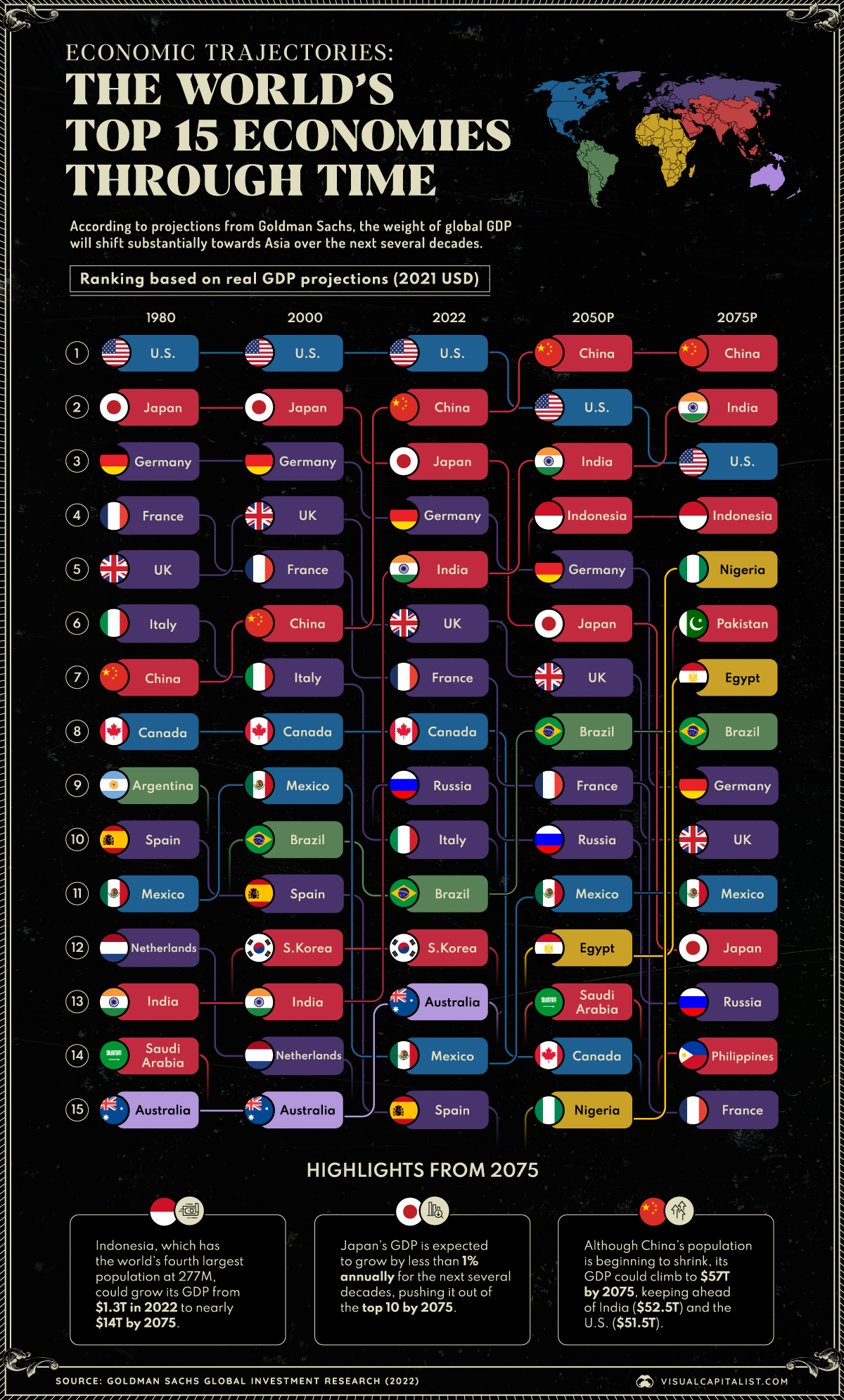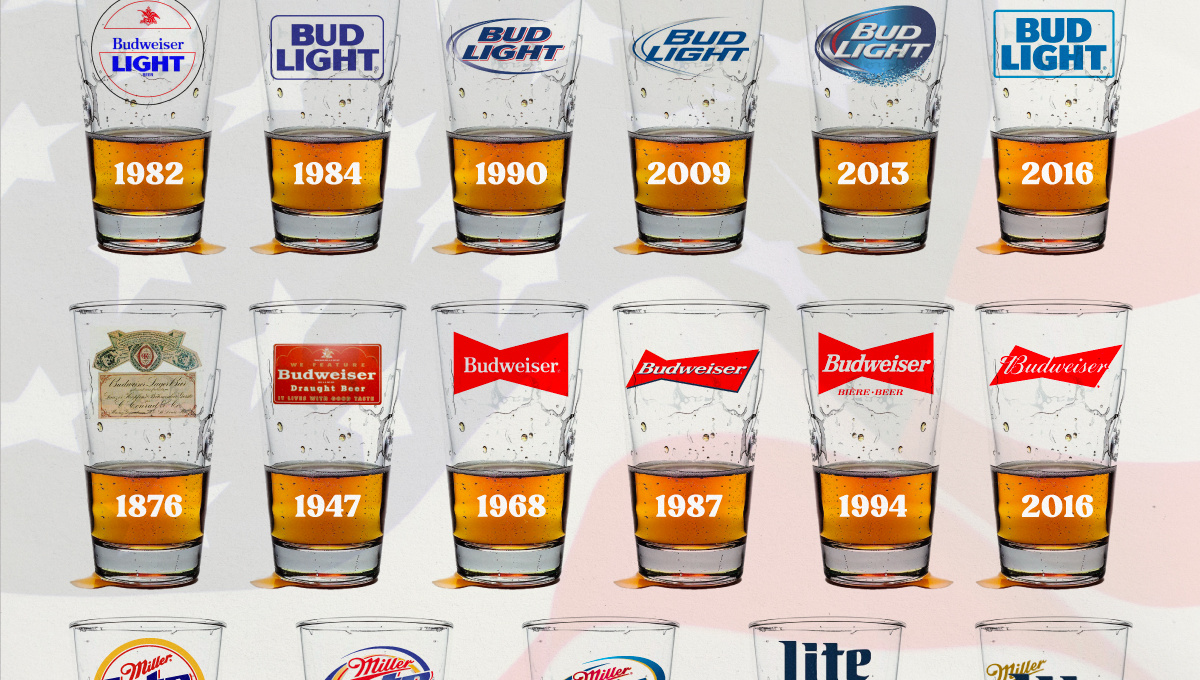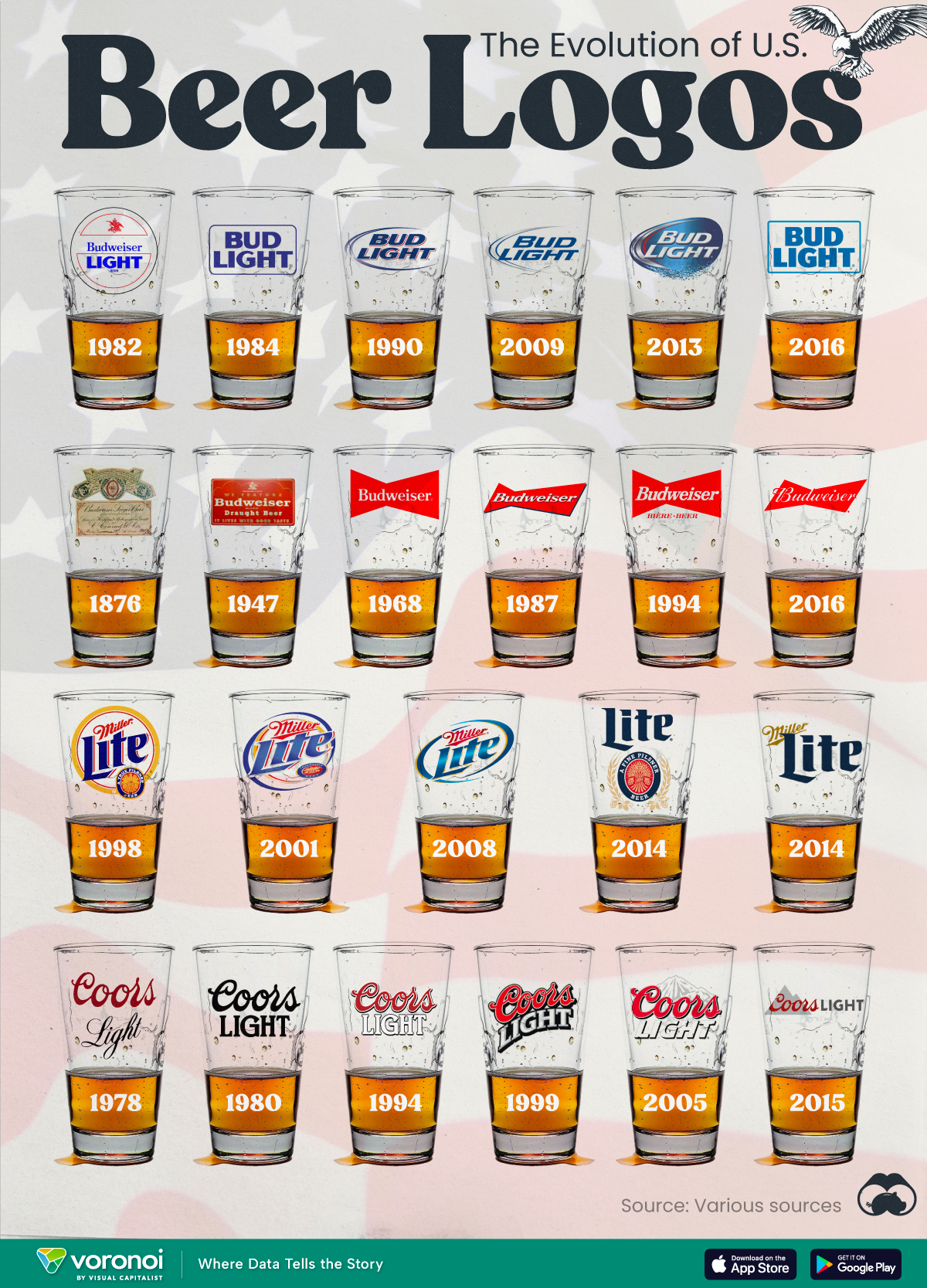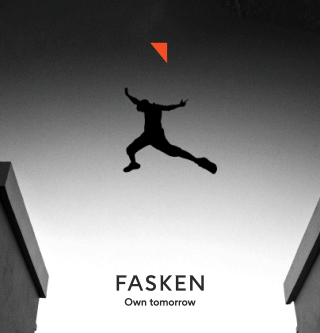United States
Ranked: The Top Economies in the World (1980‒2075)

Visualizing the Top Economies in the World
According to a recent report from Goldman Sachs, the balance of global economic power is projected to shift dramatically in the coming decades.
In the graphic above, we’ve created a bump chart that provides a historical and predictive overview of the world’s top 15 economies at several milestones: 1980, 2000, 2022, and Goldman Sachs projections for 2050 and 2075.
Projections and Highlights for 2050
The following table shows the projected top economies in the world for 2050. All figures represent real GDP projections, based on 2021 USD.
| Rank | Country | Real GDP in 2050 (USD trillions) |
|---|---|---|
| 1 | 🇨🇳 China | $41.9 |
| 2 | 🇺🇸 US | $37.2 |
| 3 | 🇮🇳 India | $22.2 |
| 4 | 🇮🇩 Indonesia | $6.3 |
| 5 | 🇩🇪 Germany | $6.2 |
| 6 | 🇯🇵 Japan | $6.0 |
| 7 | 🇬🇧 UK | $5.2 |
| 8 | 🇧🇷 Brazil | $4.9 |
| 9 | 🇫🇷 France | $4.6 |
| 10 | 🇷🇺 Russia | $4.5 |
| 11 | 🇲🇽 Mexico | $4.2 |
| 12 | 🇪🇬 Egypt | $3.5 |
| 13 | 🇸🇦 Saudi Arabia | $3.5 |
| 14 | 🇨🇦 Canada | $3.4 |
| 15 | 🇳🇬 Nigeria | $3.4 |
A major theme of the past several decades has been China and India’s incredible growth. For instance, between 2000 and 2022, India jumped eight spots to become the fifth largest economy, surpassing the UK and France.
By 2050, Goldman Sachs believes that the weight of global GDP will shift even more towards Asia. While this is partly due to Asia outperforming previous forecasts, it is also due to BRICS nations underperforming.
Notably, Indonesia will become the fourth biggest economy by 2050, surpassing Brazil and Russia as the largest emerging market. Indonesia is the world’s largest archipelagic state, and currently has the fourth largest population at 277 million.
The Top Economies in the World in 2075
The following table includes the underlying numbers for 2075. Once again, figures represent real GDP projections, based on 2021 USD.
| Rank | Country | Real GDP in 2075 (USD trillions) |
|---|---|---|
| 1 | 🇨🇳 China | $57.0 |
| 2 | 🇮🇳 India | $52.5 |
| 3 | 🇺🇸 US | $51.5 |
| 4 | 🇮🇩 Indonesia | $13.7 |
| 5 | 🇳🇬 Nigeria | $13.1 |
| 6 | 🇵🇰 Pakistan | $12.3 |
| 7 | 🇪🇬 Egypt | $10.4 |
| 8 | 🇧🇷 Brazil | $8.7 |
| 9 | 🇩🇪 Germany | $8.1 |
| 10 | 🇬🇧 UK | $7.6 |
| 11 | 🇲🇽 Mexico | $7.6 |
| 12 | 🇯🇵 Japan | $7.5 |
| 13 | 🇷🇺 Russia | $6.9 |
| 14 | 🇵🇭 Philippines | $6.6 |
| 15 | 🇫🇷 France | $6.5 |
Projecting further to 2075 reveals a drastically different world order, with Nigeria, Pakistan, and Egypt breaking into the top 10. A major consideration in these estimates is rapid population growth, which should result in a massive labor force across all three nations.
Meanwhile, European economies will continue to slip further down the rankings. Germany, which was once the world’s third largest economy, will sit at ninth behind Brazil.
It should also be noted that China, India, and the U.S. are expected to have similar GDPs by this time, suggesting somewhat equal economic power. As a result, how these nations choose to engage with one another is likely to shape the global landscape in ways that have far-reaching implications.
Misc
The Evolution of U.S. Beer Logos
In this graphic, we analyze the evolution of popular U.S. beer logos like Budweiser, Coors Light, Bud Light, and more.

The Evolution of U.S. Beer Logos
This was originally posted on our Voronoi app. Download the app for free on iOS or Android and discover incredible data-driven charts from a variety of trusted sources.
Despite selling a popular product, beer companies have to be creative to stand out in a competitive market.
In this graphic, we analyze the evolution of some U.S. beer logos based on various sources. We chose brands based on a mixture of criteria, including popularity (based on YouGov surveys), availability of logo assets, and those with interesting developments.
Bud Light Back to the ’80s
Despite recent backlash and calls for a boycott after sending a commemorative can to transgender influencer Dylan Mulvaney, Bud Light remains one of America’s best-selling beers.
The brand of light beer, owned by the Anheuser-Busch company, has switched from its more circular logo with italic letters adopted in the 1990s back to the Bud Light badge of the 1980s. It is composed of heavy uppercase lettering, written in two levels in a shade of blue with the inscription placed on a solid white background and enclosed in a thin rectangular frame.
Miller Lite Goes Old School
After following a similar approach to Bud Light’s branding throughout the 2000s, Miller Lite decided to undergo a major rebranding in 2014.
The company returned to its 1970s roots, once again combining a white can with its original blue, gold, and red logo. The redesign was largely considered a success, given that Miller Lite sales immediately increased following the change.
A Symbol of American Brewing
The oldest brand on our U.S. beer list, the Budweiser logo, has undergone more than 15 changes over the years.
The design of two connected triangles represents a red bow tie, as a symbol of American brewing.
The colors of the Budweiser logo include a vibrant red, which helps the logo stand out and be easily recognizable from a distance. Studies also suggest that the color red stimulates appetite. Meanwhile, the white inscription symbolizes purity and cleanliness.
Curious to learn more about the beer market? Check out this graphic about global beer consumption.
-

 Markets6 days ago
Markets6 days agoVisualized: Interest Rate Forecasts for Advanced Economies
-

 Markets2 weeks ago
Markets2 weeks agoEconomic Growth Forecasts for G7 and BRICS Countries in 2024
-

 Wealth2 weeks ago
Wealth2 weeks agoCharted: Which City Has the Most Billionaires in 2024?
-

 Technology2 weeks ago
Technology2 weeks agoAll of the Grants Given by the U.S. CHIPS Act
-

 Green2 weeks ago
Green2 weeks agoThe Carbon Footprint of Major Travel Methods
-

 United States1 week ago
United States1 week agoVisualizing the Most Common Pets in the U.S.
-

 Culture1 week ago
Culture1 week agoThe World’s Top Media Franchises by All-Time Revenue
-

 voronoi1 week ago
voronoi1 week agoBest Visualizations of April on the Voronoi App

















